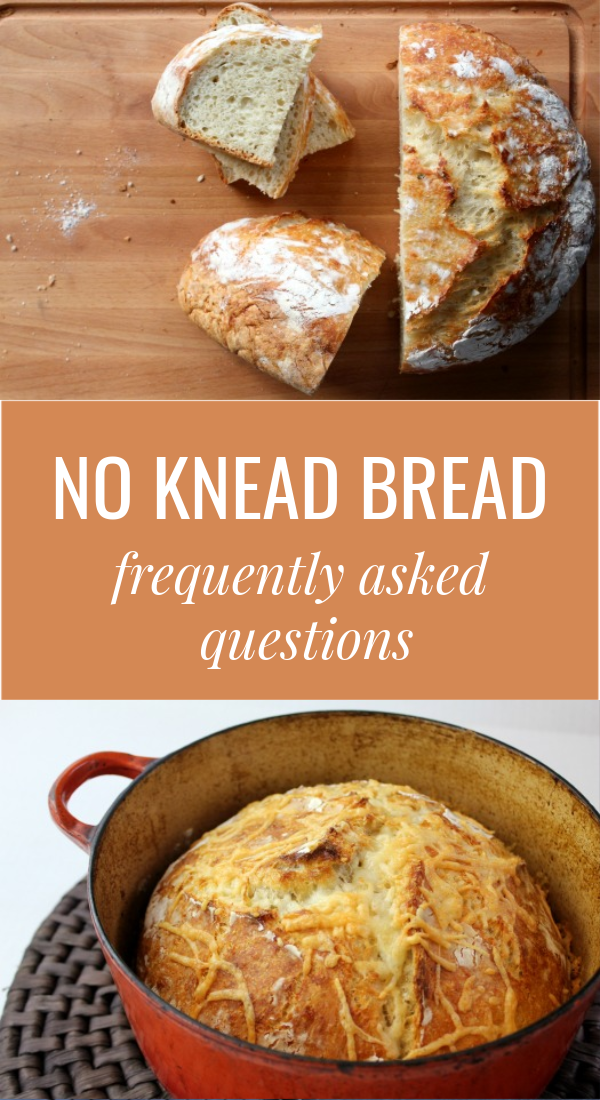

Comments keep rolling in each week for our Jim Lahey’s Basic No-Knead Bread post. Some of you are baking pros and others have never baked a loaf of bread in your life. Hundreds of you have tried this recipe and have come to the same conclusion: this is some seriously delicious bread.
I would have to agree. I have baked dozens of these beautiful loaves since I first tried the recipe over a year ago. My Dutch ovens don’t have a chance to gather dust (find affordable dutch ovens on Amazon here) and my husband is one happy camper. All signs point to success.
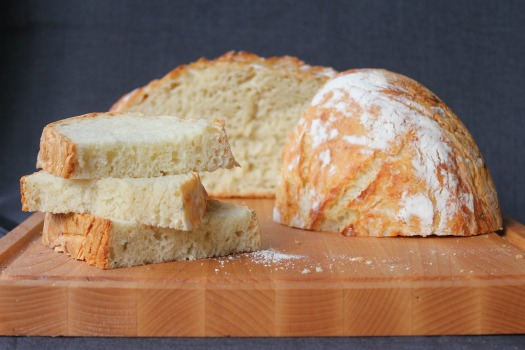
I love reading your comments and hearing about your bread-baking success in the kitchen. Here are a few examples:
I did it! It’s sitting on my counter crackling right now. It’s beautiful! Besides my kids, it’s the prettiest thing I’ve ever made! – Kristen C.
I just adore this recipe and how versatile it is! We had guests for dinner and they ate it all!! – Stephanie
Thanks for making a baking idiot look like a master. – Tim
We managed to let it cool before slicing. It is absolutely delicious – we love the chewy texture, and the crust is wonderfully crunchy. It’s now wrapped in a towel on the counter, and it’s about all I can do to stay out of the kitchen! – Mary C.
I entered a loaf of this bread in our local county fair (along with sheep) and WON!! Not only did I win, but a gentleman (also entering his sheep) won the same award for the exact same bread!!! – Adrienne
Ok, so… yeast scares me, never made bread but thought I’d give this a go. Forgot to mix dry ingredients before adding water. Due to family tragedy, dough sat out for 24 hours. By the time I got around to baking it I was so tired that I only let it rest for 11/4 hours. Only had Pyrex to bake it in… All that and it still came out great. Cooling on rack now. 1 plain, 1 cinnamon raisin. Smells great, can’t wait to try. Apparently, you can not kill this bread! – Debbie
I just made this… it is AWESOME! So very easy.. the hardest part was waiting for it to cool enough to cut! We are big bread people & very picky.. this tops the list! – Valerie
Let me just preface this comment with my bread-baking skills: They’re nonexistent. I’ve ruined everything from breadsticks to cinnamon rolls before… no matter how easy they seemed. This is the FIRST bread recipe I’ve ever tried that’s ever actually baked looking anywhere near the recipe. It turned out beautifully. – Robyn
I just made this tonight and I have to say…..I CAN’T BELIEVE IT IS HOMEMADE…..It is the best bread I have ever made. – Sarah
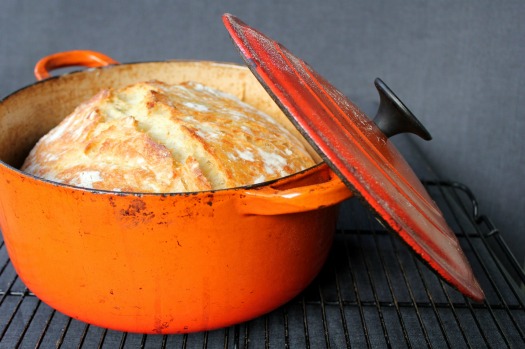
No-knead bread plays well with amateur bakers so do not be intimidated by the steps. This recipe is really forgiving (a.k.a. hard to mess up). Even if you let it rise too long or add too much water, odds are, you are still going to end up with a good loaf of bread.
I would recommend following the directions closely the first time you try this. With practice, you will start to develop a feel for how it should look, smell, and taste. Variations of ingredients, temperature, and technique could all affect your dough. It is much better to go by smell and sight than get stuck on exact times. Adjust moisture levels, rise times, and bake times if needed.
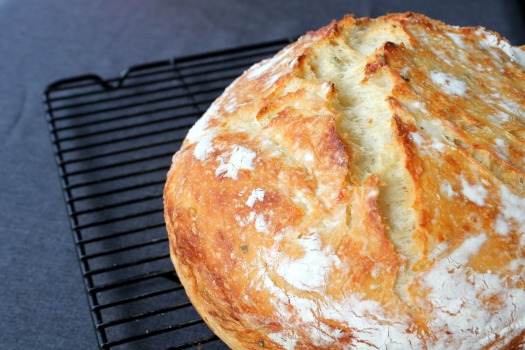
Below, you will find answers to some of the most frequently asked questions out of the 400+ comments we have received so far.
Basic No-Knead Bread FAQ’s:
Q: Help! My dough is too wet. What do I do?
A: This recipe will make a wet dough. You can add flour, a tablespoon at a time, until it reaches the correct moisture level.
My best advice, though, is just to use well-floured hands and towels and work quickly with the wet dough. You don’t want it to be a shapeless blob, but it should be somewhat wet and sticky. The moisture is what creates the steam which is what creates that trademark crust and crumb.
Q: Help! My dough is too dry. What do I do?
A: Add water, a tablespoon at a time. Also keep in mind that the dough does hydrate as it rises.
Q: Do I need to oil my Dutch oven?
A: No, you don’t. The high heat will create a crisp crust around the bread, similar to searing a steak. I have had three loaves stick; I believe it was from not pre-heating the pot for the full 30 minutes.
If a loaf sticks, it is frustrating. Just run a plastic knife around the outside of the bread, working it in at an angle to release the loaf from the pot. Then turn it upside down and shake vigorously until the loaf pops out. It always does, though you may break a sweat in the process.
If you consistently have issues with the bread sticking in the pan, pour 1-2 tablespoons of olive oil into the pre-heated Dutch oven and spread it around quickly with a paper towel before dumping the dough into the pot.
Q: Is there any way to cut the salt without risking the integrity of the bread?
A: From Frugal Living NW readers: “I use either salt substitute – potassium chloride (KCl) or the Lite Salt which is half sodium chloride and half potassium chloride. Both work equally well.” and “I don’t use salt, and it is awesome! Use herbs — rosemary, basil, whatever, they all come out good!”
Q: I don’t own a Dutch oven. Can I use a different pot?
A: Any heavy, ovenproof lidded pot rated for high heat will work. Readers have reported success with glass and clay pots. Some creative readers have even used a cookie sheet over a pot as a lid!
Q: Can I add in any additional ingredients?
A: Go for it! Add additional ingredients to the dry flour mixture before adding the water. This ensures that they incorporate evenly. Here are a few variations either Frugal Living NW readers or I have tried (you can find more no-knead bread variations here):
- 2 T. tomato paste, 1/4 c. Parmesan cheese, 1/4-1/3 c. basil
- 1-3 T. brown sugar, sugar, or molasses
- cinnamon & raisins
- grated cheese
- 1/3 c. honey, 3/4 c. chopped walnuts, 3/4 c. Craisins, orange zest
- 100% whole wheat, while exchanging 1/4 c. of flour with 1/4 c. vital wheat gluten
- for rye bread: use a 1:2 ratio. (1 c. of rye for every 2 c. of regular flour). Optional: add 1 T. caraway seeds
- for richer bread: 6 T. buttermilk powder
Q: I live at a high altitude? Do I need to make any adjustments?
A: Nope! Your dough will probably rise faster, but other than that proceed as written.
Q: The exterior of my bread turned out crispy and the interior turned out chewy. There are lots of big holes. Did I do something wrong?
A: Sounds like you did everything right! This type of artisan bread will have holes in the interior and a thicker, chewier crust. (In Lahey’s book, his crusts are dark and almost charred looking.) To “fix” this problem would take away what makes this bread unique.
That being said, as long as the interior temp is at 200 degrees and the crust is a nice golden brown, pull it out of the oven. Try decreasing your baking time a bit. I also wonder if a sheet of foil under the pot would give you a lighter bottom crust?
If that still doesn’t meet your expectations, try a different recipe, like this one for hamburger buns (make in any shape you want) that will give you a thin crust and soft, light interior.
Q: Can I use a smaller (3-5 quart) Dutch oven or ovenproof pot?
A: If you are working with smaller pots or appetites, just cut the ingredients in half. Follow the mixing and rising steps as written. Bake at 425 for 30 minutes, remove lid and bake for another 15-30 minutes (until internal temp is 200 and it’s golden brown).
Q: Can this bread be frozen?
A: Yes! Bake the bread as directed, cool it, wrap it in foil, then slide it into a reusable plastic bag. The trick would be finding a big enough bag… Maybe cut the recipe in half if you want to freeze it? Then just slide the foil-wrapped loaf into a hot 350-degree oven until it is heated through.
*************************************************************************

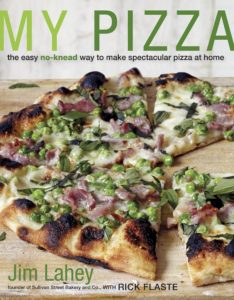
If you have mastered this basic bread, you need to check out the other recipes in My Bread: The Revolutionary No-Work, No-Knead Method by Jim Lahey.
Lahey has also come out with a book on pizza! Be still, my carbo-loving heart. My Pizza: The Easy No-Knead Way to Make Spectacular Pizza at Home is on my Amazon wishlist as we speak. Amazon has both books in stock and ready to ship.
Looking for more delicious bread recipes?
This post may contain affiliate links. See the disclosure policy for more information.


I have made this bread several times and it comes out perfect every time but now I want to add shredded cheese to it. How much should I add?
Angela, I wanted to thank you for this recipe. The instructions were extremely clear, and my 19yo daughter followed them to successfully make her first loaf of bread. She was so proud, and we all enjoyed the results! Thank you for inspiring her to try something new and giving us a fun activity to enjoy together.
My dough looked OK when I first mixed it. But 18 hours later, when I went to punch it down for the second rise, it was very wet. Could I have added flour at that time? Or was it already too late? (I didn’t want to risk adding flour, and I wound up with a loaf whose thickness was closer to pita.)
I made this recipe with complete success the first time. I have now tried three additional times and it has not risen properly. I followed the directions to a t. Last night i covered it and placed it in my cool oven overnight, not bubbly at all this morning. What am i doing wrong? The yeast is a new pack i just bought that expires in July 2021. Please help
As an ex-professional baker, I would suggest you check to make sure your yeast is still good. I know the packet says it is, but I would try another packet with about 1/4 cup warm water and a spoon of sugar. If there are no bubbles, then the yeast is bad.
Alternately, it is possible that your salt is killing your yeast before it can work. Try to mix them both into the flour on opposite sides of the bowl before adding your water and see if that helps.
Hello!
I tried making this bread today and while it looks gorgeous and smells amazing, I can’t get it out of the pot! It’s stuck to the bottom although the sides came away just fine. HELP!
There’s a section here about using a little bit of oil in the pot before cooking, you could try that next time? Did you have any luck getting the bread out?
I cool the bread on a rack, but after 30. min. the crust is getting soft. What am I doing wrong.
Hi. The crust turned out all crisp and golden brown but the inside was dense and looked under cooked. What did I do wrong,
How did it taste? The texture of this bread is a bit different than “traditional” bread.
I have been baking variations of no-knead bread for over three years in a Lodge, 7-quart, cast iron Dutch oven. My first few loaves all had scorched bottoms even with parchment paper. The BEST fix for this was when I started using the Lodge, cast iron trivet (8DOT). A trivet is a MUST HAVE item when baking in cast iron! (Great post, BTW!)
I bake no knead bread in dutch oven looks great but the crust and buttem of bread so tufgh and tried 3 times the same problem and I made no knead ciabatta bread it was so pale almost white please help me what is the reason
Use a trivet on the bottom of the Dutch oven, as well as parchment paper.
Why did my bread develop a crust when rising the first time
Walmart has 2 gal, 2 1/2 gal, and 3 gal zip lock bags. So matter the size of your loaf they have a bag for you. 🙂
i was told that the Dutvch oven should preheat at 450 or 475 and the dough should cook at that temperature . 425degrees does not seem hot enough . please reply.
Have you tried the recipe yet? We have tons of readers who have made it as written and it’s turned out great! If you have another recipe with different instructions, you’re welcome to give those a try here but we can’t guarantee results.
I am wondering why you have the wait time from the bowl to the floured surface. What would happen if you go straight from bowl to the hot roasting pan? Would it still work?
works fine. There is another comment on this at the bottom of Comments in 2014
I’m following your recipe to the letter, and so far the best rise I’m manged to get is three inches. I tested my yeast–it’s fine. I’m using King Arthur bread flour, and it’s fresh. My Dutch over in an Emile Henry. I’m using the “Bake” mode, (vs the “Convect Bake” mode) All I can see as an issue is that although the dough has risen nicely, when I move it into the hot Dutch oven after the second rise, it ends up coming out of the oven looking just like it did doing in. Any ideas? Thanks!
Can you make this bread with gluten free flour?
Unfortunately, just subbing 1-for-1 with GF flour won’t get you the same results. You’d have to find a recipe with liquid ingredients and instructions specifically for gluten-free.
Circling back to this, I’ve done some research and it looks like some have made this with GF flour with great success! Rise may not be quite as high, but should still work okay.
Hello, I live at 6000 ft. And sometimes my dough gets runny not sure why. Can I add flour to my no kneed dough after its been rising. It’s seems to be to watery an risingg very slow even though I’ve got the heat cranked up.
Can I bake this bread in a pyrex without a cover?
I love these breads, but I think the interior is too moist. I use a temperature probe towards the end, looking for 205-210 degrees. Outside is gorgeous, but the insides could be drier. Is this the nature of these breads compared to tradition knead breads? Is there any way to get the interior a bit drier? Like more flour, bigger pot, etc? Thanks.
I do not have a wooded spoon hook, can I do this in my kitchen aid mixer using my dough hook?
We love, love, LOVE this bread!!!
He are two of my own variations:
Half whole wheat, half white bread flour, 1/4 c. molasses, 1 to 1/2 c. raisins, and (optional) 1 to 2 tsp. cinnamon. Fantastic.
Second idea–right before the dough is plopped into the Dutch oven, I paint the top of the dough with a beaten egg. Then I sprinkle kosher salt and sesame seeds on top. The result is a wonderful, crunchy top kind of like a bread stick or salt stick. Yum.
Hildy 🙂
thanks for all your good information. i live at 6500 feet and just finished making a perfect loaf using the same amounts that i did with my daughter-in-law (teaching her how to bake) at sea level. great recipe. i used a copper pan and it worked beautifully.
Hi My 1st loaf looks exactly like yours and hit the important internal temperature but it’s not making any noise while cooling. How long/at what temperature can I cut it so it doesn’t lose it’s integrity?
BTW had ambient temperature if about 10C so it was prooving for almost 36 hours before the 2 hour proof in a towel
How can I add flaxseed meal to the dry ingredients in this recipe?
Thx.
James.
can you extend the time from 24 hours to 48 hours for the first step of the Jim Lahey no knead bread recipe?
when you say use 1/2 T yeast, is that a teaspoon or tablespoon
It’s actually 1/2 t. yeast
t = teaspoon
T = Tablespoon
Happy baking!
Lower case “t” is teaspoon
Upper case “T” is tablespoon
i can’t find the recipe for the tomato Basil bread. can you tell me where to look. it said it was at the end but when i clicked on it nothing happened. thanks
Hello, would it be possible to bake without a cover? I do not won a dutch oven nor a oven safe lid or pot. I wanted to bake it in my cast iron skillet, but it does not have a cover. Any suggestions? Also, does the bread rise significantly in the oven? Or would it be similar to the dough size before being baked?
Would it be possible to give this apparently great recipe in metric measures? We don’t use “cups” but grams, and I don’t really trust converters, as they are never precise (several converters gave different measures…)
Tks in advance
I have seen “cups” of flour that weigh various amounts, from 125 grams up to 140 grams. If you have a scale and a cup, you could see how much flour your cup contains.
In this case, it is handy to know the flour:water ratio.
Jim Lahey’s No-Knead Bread Dough Ratio:
100 parts flour
1.5 parts salt
1 part yeast
70 parts water
So let’s say that you go with 500 grams flour (4 x 125 g), then you know that you need 1.5% = 7.5 g (round up to 8 g) salt, one part yeast (1 g of yeast is hard to measure, so I’d suggest to experiment with the number of 1/4 tsp you need to get the result you want, which may be different in summer and winter), and 70% water, which is 350 g.
Hope this helps!
Happy baking…
I’m diabetic, so bread, pasta, & potatoes are a limited item. Just today, my doc says to eat gluten free. I made the no knead bread with half whole wheat yesterday and it’s so good. Can this be made with gluten free flour?
Unfortunately, just subbing 1-for-1 with GF flour won’t get you the same results. You’d have to find a recipe with liquid ingredients and instructions specifically for gluten-free.
I make this bread all the time, and it is consistently great. But this time, my dough, after sitting overnight, was watery at the bottom… bubbly as usual, but sitting in liquid. This has never happened before… I added more flour, and am letting it re-rise… any words of wisdom?
Hello,
Instead of using never-bleached white flour, I’ve started using ORGANIC never-bleached white flour, and all of a sudden, the dough behaves differently. I usually let the dough sit for 24 hours, then bake it, but recently the breads were way more dense than usually. My last dough I let go for 24 hrs + 7 hrs extra and the dough showed the familiar bubbles and rose during baking. The yeast seems to be fine (my husband used it for pizza dough and it came out fine). Does anyone else have experience with organic flour?
The answer seems to be that I need to use more yeast in the winter, when my kitchen is cold. I have tripled the amount of yeast and my breads come out great with the desired 24-hour rising time.
If your kitchen is chilly, try popping it in the oven and keeping the oven light on for an hour or two (if I keep my light on longer, oven actually gets too warm)
I tried baking this on the weekend and managed to get a really nice loaf of bread, only it was much more dense then the pictures of the loaf on this site. I’m using stone milled unbleached white wheat flour so not sure if that would have effected the loaf, might need to get myself some better yeast maybe.
I would love to try this bread. Sounds delicious. I do have a slight problem. I have severe arthritis in my hands and use my Kitchen Aid mixer for mixing. Could I use it to do the mixing for this bread? Thanks for your help.
Yes I usually do use my kitchen aid
Thanks so much for your reply. I can’t wait to try this bread.
Has anyone switched out the regular flour for gluten-free flour? I have a gluten-free flour that is a 1:1 ratio substitute for regular flour. I think I’ll try it. Any suggestions?
I would like to know about the GF flour substitution too! 🙂
I made this recipe last weekend and was so excited at how wonderful the bread turned out! I’ve never made bread before and so proud of myself haha! My question is, if I cut the ingredients in half, can I still bake it in my regular sized Dutch oven, or do I need a smaller one? I have a 5.5qt one. Thanks so much for your help!
That is great! You should be proud.
Your 5.5 quart will work fine with a half recipe. It will just give you a flatter loaf.
I made a mistake and only used 1/4 t. yeast for 3 cups of flour. After 12 hours the dough is too loose and wet. Should I throw it away or can it be fixed?
That would be 1/2 recipe. Did you use the full amount of water? If so, I would add another 1/4 t. of yeast and 3 more cups of flour. Stir it together and let it rise for another 8-10 hours. I’ve never done that, but this recipe is really forgiving. It won’t give you perfect results, but I think it will still turn out great.
Thank you very much Emily. I used half of the water but I don’t know what happened. I made another dough and this time looks much better 🙂
1/4 tspn is fine, just takes a little longer. If dough too is too cold then move it to a warmer spot. The dough is normally damp and sticky but If after another six hours or so you still feel it is too wet then can mix in a little more flour without an issue. Flour a surface, tip the dough onto it and pat it down if necessary; sprinkle more flour over it, fold it in thirds sprinkling more flour over the surface, maybe pat it down again, flour and fold then put back in the bowl for second rise. No matter the outcome, make some notes and you will build your knowledge of how flexible the recipe is to tweak it.
Thank you very much! I made a new dough and this time looks much better. I used 1/2 tspn yeast and 4/3 cup this time. The other one, I added flour. Let’s see what happens *crosses fingers*
I have got lazy with my approach to NKB, seems the recipe just works no matter what you do; I mix 3 cups flour, 1 tspn salt, 1/2 tspn yeast and 4/3 cup tepid water in the evening, which takes two minutes, cover bowl with a plate then next morning preheat oven to 220C ( 430F), warm my clay baking pot and pop dough in the oven with lid on for 40 mins or so. No second rise, no taking the lid off, no mess. Comes out golden, crusty and tasty every time.
I tried this method a few times and the bread is great.
My question is why is my dough a little moist and mushy and the crust is crispy and great ?
I asked this same question awhile ago but no one has offered any answer yet.
I can think of a couple reasons it might be too moist… If you cut bread while it is still warm, steam will settle on blade can cause bread to get soggy… or you may need to add a bit more cook time with lid on. I also want to throw out there to make sure to heat your cooking vessel in oven and make sure it is good and hot before you put dough in pot.
I routinely do all of the things you listed. it’s just that the crumb is always so MOIST. I usually cool the loaf completely, slice and then freeze. Recently I’ve begun not slicing or freezing, leaving the loaf on wooden cutting board, covered with a linen towel and that helps but isn’t practical for a household of one.
I’ve tried this bread a couple times and the exterior was beautiful, but the inside was a bit too moist. This last time I lowered the 1 1/2 cup water by a few tablespoons, but still, the inside was a bit too moist. I even waited 18 hours and did everything per instructions. I hope someone has an answer.
Different flours have different moisture contents so maybe hold back on the water a little or try a different brand of flour; for three cups 00 flour I never use more than 4/3 cup tepid water. Use even less if have some wholemeal flour in the mix. When I was baking bigger loaves I used a similar 9:4 flour to water ratio. You might try a different size pot to change the surface area of the dough; my loaves are usually four to five inches high depending on the pot. Another thing to try is increasing the bake time with lid on by a few minutes; I do 40 to 45 mins lid on with three cups of flour. Just keep notes and experimenting to discover what works for you.
Thank you for your comments
I made the bread again the crust was great the crumb had large holes and the rest was dense and a bit wet. I pulled out the crumb and ate the crust ONLY …. UGH !!! I can’t bring something like that to my friends and family …. HELP !!!
I was wondering if my pot was too large , it’s 6 quart
I just got a 4 quart will this help ???
Also, is it okay to use “fresh yeast” ??
Can you make rolls out of this recipe?
If so do I need to adjust rising time?
Any tips would be appreciated!
I have made the bread twice now. The first time I baked the bread at 450F for 30 mins with the lid on and 15 mins without the lid on. The bottom of the bread was burned. The second time I baked it at 450F for 20 mins with the lid on and 10 mins without the lid on. It was still burned but not as much as the first time. I had my oven thermometer inside both times and I knew the temperatures were correct. So the question is: Should I decrease the temperatures to 425F or even 400F, or should I decrease the baking time, or both? Thanks.
The recipe lists a baking temp of 425, so start there! If the bottom crust is still darker than you’d like, I’d try decreasing it to 400. I have noticed that some of my Dutch ovens conduct the heat differently. That being said, Lahey bakes his loaves until they are quite dark, almost charred looking! Different strokes for different folks! 🙂
Hi,
I have been messing around with no-knead bread off and on for a couple of winters. This is the first time I got the recipe to turn out.
I did have trouble with way too wet dough and had to add a lot more flour. From my past experience I baked the bread at 400 instead of 425 and also only heated the pot for about 10 minutes. Otherwise I get a very flat loaf. This loaf had nice texture, taste and a crunchy crust.
I did use my bigger dutch oven and that may have played apart In my success. I will be printing out the recipe and filing it for future use.
Thanks Jan
Can you substitute in sourdough starter? I use my starter all the time wondered if it would work in this recipe. thx
What if the second rise lasts for 4 hours? Is that too long? Anyone tried it?
This bread is very forgiving and it should turn out fine.
Has anyone left it for like 4 hours for the second rise? How did that turn out? Too long?
I have what may sound like a goofy question. I have the Lodge cast iron dutch oven and have 2 different lids for it. The one to use when you want to put charcoal on the lid and the one that has the little knobs inside that drip moisture when cooking – which one should I use when I bake this bread? Thanks.
I have the one with the small knobs (kinda pointy?) inside and it’s worked great. I haven’t seen the one where you can put charcoal in the lid. Is that a flat or rounded lid? Either way, the important part is that it’s a closed lid.
Kate, thank you for your answer. I will use the one with the knobs then. The one that you put charcoal on is flat and actually has about 1/2 sides and sits more down into the pan.
Oh, I think I know which one you’re talking about now. Hope it works out great. It’s so delicious I can’t make it unless I’m planning to go to a party. I would definitely have a bread baby for days!
Just found this and the faq. Is it possible to substitute gluten free flour to get the same or similar result?
No, you won’t get similar results with a straight substitution. I haven’t found a single similar GF recipe that people are excited about so far… Interested in coming up with one? 🙂
If I halve the recipe, how long would you suggest I cook it?
Thanks!
I would try for half the time and take a peak. If it looks like it’s browning then remove the lid and cook for an additional 10 minutes longer.
Thanks so much! We are having fun with this recipe.
We’re glad you found it, Tiffany. We’d love to hear more about any changes or additions you’ve made!
I’ve made this bread several times now and it’s turned out great each time. It’s the easiest and the yummiest bread I’ve ever made…we love it!!
Thank you for the recipe, my bread came out perfect. I was hoping to find a pumpernickle recipe. Any suggestions using the same easy technique.
Hi,
I just started using Jim Lahey’s technique for making bread. I am using 50 % whole wheat and 50% white. The taste and look of the bread is all good, just a little dense…. however it doesn’t rise very much- even after 18 hours and the 2nd rising! He said we should get a 10 inch loaf, mine only is about 7inches after baking. I checked my yeast and it is good.
Could it be the cool water he calls for????. Should the dough be sticky or more tacky??? Any suggestions?????
thx
deb
Whole wheat will give you a denser, smaller loaf. And you’re right, it won’t rise as much either. I sometimes prep/bake 2 loaves at the same time – 1 with all white unbleached flour and one half & half (white & whole wheat). The look of the rises & final loaves are definitely different – just as you described! My dough is usually pretty wet & sticky, but not so bad it can’t be handled with floured hands. Sounds like you’re doing everything right! Hope that helps!
I make my whole wheat with just one cup of wheat flour and two cups of unbleached AP flour (I use the recipe for a small pot). So, if you’re using the six cup recipe, then use just two cups of wheat flour.
Also, as I posted before, you don’t need to do the second step. Trust me, I’ve been making this for several years by just mixing the dough, and then baking it anytime the next day–it comes out consistently perfect each time.
I should elaborate on my prior comment: that I don’t bother with the second step.
When the oven and cast iron pot are heating, I generously dust the dough nearest the entire edge of the bowl using a flour sifter. Then I loosen the wet dough from the bowl using a stiff rubber scraper and, as I loosen it, I’m also coating it with the flour and forming a ball of soft dough–which I then dump (or roll) into the center of the fully heated cast iron pot without needing to touch or otherwise work the dough at all. I then cover the pot, and about 25 minutes later, I remove the lid and bake for another five minutes or so to brown the top.
And that’s it–no kneading, no punching down, and no second step as called for in the original recipe. Just mix the dough in the evening, and bake anytime the next day. It’s so very simple, yet such a huge hit with my potluck group that they’re disappointed if I don’t show up with it on time–still warm from the oven!
Dave, so you totally skip the second rise?
Yes, I’ve been skipping the second rise for years and can see no difference in taste or quality. This is what makes this so simple–I just mix the dough on a Friday evening, and then turn it out and put it in the oven just before I shower and change for the potluck on Saturday evening–and it’s still warm when I arrive.